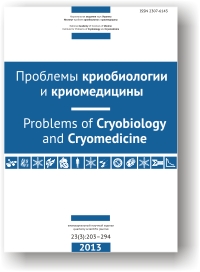КлиничеÑкий опыт иÑÐ¿Ð¾Ð»ÑŒÐ·Ð¾Ð²Ð°Ð½Ð¸Ñ ÐºÑ€Ð¸Ð¾ÐºÐ¾Ð½Ñервированных Ñпермиев, полученных при биопÑии у пациентов Ñ Ð°Ð·Ð¾Ð¾Ñпермией
Ключові слова:
Ñперматозоіди, кріоконÑервуваннÑ, допоміжні репродуктивні технологіїАнотація
Розроблений раніше виÑокоефективний метод кріоконÑÐµÑ€Ð²ÑƒÐ²Ð°Ð½Ð½Ñ Ð½Ð¾Ñ€Ð¼Ð¾Ð·Ð¾Ð¾Ñпермічного еÑкулÑту було заÑтоÑовано Ð´Ð»Ñ Ð¿Ð¾Ð¾Ð´Ð¸Ð½Ð¾ÐºÐ¸Ñ… епідидімальних Ñперміїв з метою викориÑÑ‚Ð°Ð½Ð½Ñ Ð² програмах допоміжних репродуктивних технологій (ДРТ). Клітини охолоджували в капілÑрах з розчином 20% Ñахарози Ñ– 15% гліцерину від 22 до –35°С зі швидкіÑÑ‚ÑŽ 1 град/хв, від –35 до –70°С зі швидкіÑÑ‚ÑŽ 20 град/хв, а потім мікрокапілÑри занурювали в рідкий азот. ПіÑÐ»Ñ Ð²Ñ–Ð´Ñ–Ð³Ñ€Ñ–Ð²Ñƒ виживаніÑÑ‚ÑŒ Ñперматозоїдів Ñклала 92%. Ооцити запліднювали мікроін’єкцією поодинокого ÑперміÑ, піÑÐ»Ñ ÐºÑƒÐ»ÑŒÑ‚Ð¸Ð²ÑƒÐ²Ð°Ð½Ð½Ñ Ñ‚Ð° Ð¾Ñ†Ñ–ÑŽÐ²Ð°Ð½Ð½Ñ ÑкоÑÑ‚Ñ– ембріон переноÑили до порожнини матки. ЧаÑтота наÑÑ‚Ð°Ð½Ð½Ñ Ð²Ð°Ð³Ñ–Ñ‚Ð½Ð¾Ñті піÑÐ»Ñ Ð²Ð¸ÐºÐ¾Ñ€Ð¸ÑÑ‚Ð°Ð½Ð½Ñ ÐºÑ€Ñ–Ð¾ÐºÐ¾Ð½Ñервованих Ñперміїв була вищою (53,1%), ніж ÑвіжоаÑпірованих клітин (46,1%). Таким чином, показано придатніÑÑ‚ÑŒ заÑтоÑованого методу кріоконÑÐµÑ€Ð²ÑƒÐ²Ð°Ð½Ð½Ñ Ð² ДРТ Ð´Ð»Ñ Ð¿Ð°Ñ†Ñ–Ñ”Ð½Ñ‚Ñ–Ð² з азооÑпермією.
Посилання
Treatment of female and male infertility. Assisted reproductive technologies. Ed. by Kulakov V.I., Leonov B.V., Kuzmichev L.N. Moscow: Med. Inform. Agenstvo, 2005.
Khilkevich L.V., Zdanovsky V.M., Togobetsky S., Gogolevsky P.A. Additional reproductive technologies (PESA and MESA) at infertility treatment stipulated by male factor. Problemy Reproduktsii. – 1998; 2: 29–33.
Yurchenko G.G., Dunaevskaya A.V., Kramar M.I. Effect of derivation method of motile fractions of gametes from human ejaculate on their morphofunctional integrity after cryopreservation. Problems of Cryobiology. – 2001; (2): 30–35.
Craft I., Bennet V., Nicholson N. Fertilising ability of testicular spermatozoa. Lancet.– 1993; 2 (342).– C. 864.
Craft I., Tsirigotis M. Simplified recovery, preparation and cryopreservation of testicular spermatozoa. J Hum Reprod 1995; 10 (7): 1623–1627.
Desai N., AbdelHafez F., Sabanegh E. Paternal effect on genomic activation, clinical pregnancy and live birth rate after ICSI with cryopreserved epididymal versus testicular spermatozoa. Reprod Biol Endocrinol 2009; 3 (7): 142–149.
Devroey P., Liu J., Nagy Z. et al. Normal fertilization of human oocytes after testicular sperm extraction and intracytoplasmic sperm injection (TESE and ICSI). Fertil Steril 1994; 62 (3): 639–641.
Devroey P., Nagy Z., Tournaye H. et al. Outcome of itracytoplasmic sperm injection with testicular spermatozoa in obstructive and non-obstructive azoospermia. J Hum Reprod 1996; 11 (5): 1015–1018.
Gardner D., Lane. M., Stevens J. Schoolcraft W. Noninvasive assessment of human embryo nutrient consumption as a measure of developmental potential. Fertil Steril 2001; 76 (6): 1175–1180.
Hovatta O., Moilanen J., von Smitten K. et al. Testicular needle biopsy, open biopsy, epididymal aspiration and intracytoplasmic sperm injection in obstructive azoospermia. J Hum Reprod 1995; 10 (10): 2595–2599.
Jacques I., Phillips S., Hemmingset R. et al. Ongoing pregnancy after ICSI of frozen-thawed PESA-retrieved spermatozoa and IVF in a controlled natural cycle. Reprod BioMed Online 2005; 10 (5): 650–652.
Janzen N. Use of electively cryopreserved microsurgically aspirated epididymal sperm with IVF and intracytoplasmic sperm injection for obstructive azoospermia. Fertil Steril 2000; 74 (4): 696–701.
Jin L., Jiang L.Y., Zhu G.J. et al.Comparison between the results of ICSI with fresh and with frozen-thawed sperm obtained by PESA to treat azoospermia. Zhonghua Nan Ke Xue 2006; 12 (5): 443–449.
Kalsi J., Thum MY., Muneer A. Analysis of the outcome of intracytoplasmic sperm injection using fresh or frozen sperm. Br J Urol 2011; 107 (7): 1124–1128.
Munne S., Alikani M., Tomkin G. et al. Embryo quality and chromosome abnormalities after ICSI. Abstract from the IXth World Congress on IVF and Alternate Assisted Reproduction. J Assist Reprod Genet 1995; 76 (12): 76.
Ou L., Guo YH., Sun YP. et al. Outcomes of ICSI with micro-amount frozen-thawed sperm obtained by PESA or TESA in the treatment of azoospermia. Zhonghua Nan Ke Xue 2010; 16 (4): 328–332.
Patrizio P. Cryopreservation of epididymal sperm. Mol Cell Endocrinol 2000; 169 (1–2): 11–14.
Schoysman R., Vanderzwalmen P., Nus M. Pregnancy after fertilization with human testicular spermatozoa. Lancet 1993; 13 (342): 1237.
Silber S., Nagy Z., Liu J. et al. The use of epididymal and testicular spermatozoa for intracytoplasmic sperm injection: the genetic implications for male infertility. J Hum Reprod 1995; 10 (8): 2031–2043.
Silber S., Van Steirteghem A.C., Liu J. et al. High fertilization and pregnancy rates after sperm obtained from testicle biopsy. J Hum Reprod 1995; 10 (1): 148–152.
Tournaye H., Merdad T., Silber S. et al. No differences in out-come after intracytoplasmic sperm injection with fresh or with frozen-thawed epididymal spermatozoa. J Hum Reprod 1999; 14 (1): 90–95.
Westlander G., Hamberger L., Hanson Ch. et al. Diagnostic epididymal and testicular sperm recovery and genetic aspects in azoospermic men. J Hum Reprod 1999; 14 (1): 118–122.
World Health Organization. WHO laboratory manual for the examination of human semen and sperm-cervical mucus interaction. Cambridge, UK, 1999.
Downloads
Опубліковано
Як цитувати
Номер
Розділ
Ліцензія
Авторське право (c) 2020 Viktoriya V. Podufaliy

Ця робота ліцензується відповідно до Creative Commons Attribution 4.0 International License.
Автори, які публікуються у цьому журналі, погоджуються з наступними умовами:
- Автори залишають за собою право на авторство своєї роботи та передають журналу право першої публікації цієї роботи на умовах ліцензії Creative Commons Attribution License, котра дозволяє іншим особам вільно розповсюджувати опубліковану роботу з обов'язковим посиланням на авторів оригінальної роботи та першу публікацію роботи у цьому журналі.
- Автори мають право укладати самостійні додаткові угоди щодо неексклюзивного розповсюдження роботи у тому вигляді, в якому вона була опублікована цим журналом (наприклад, розміщувати роботу в електронному сховищі установи або публікувати у складі монографії), за умови збереження посилання на першу публікацію роботи у цьому журналі.
- Політика журналу дозволяє і заохочує розміщення авторами в мережі Інтернет (наприклад, у сховищах установ або на особистих веб-сайтах) рукопису роботи, як до подання цього рукопису до редакції, так і під час його редакційного опрацювання, оскільки це сприяє виникненню продуктивної наукової дискусії та позитивно позначається на оперативності та динаміці цитування опублікованої роботи (див. The Effect of Open Access).




